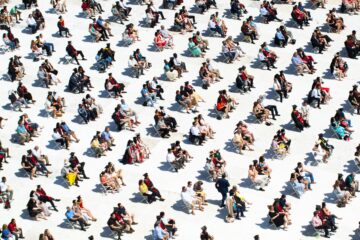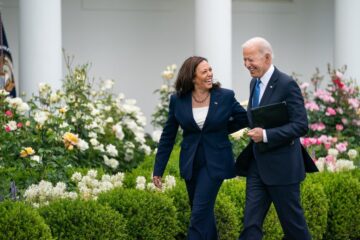Last night, America and the world lost John Lewis, a towering figure of the civil rights era and the second African-American to be sent to Congress from Georgia since Reconstruction. Our country is a better place because of his sacrifices and he leaves an unforgettable legacy of courage and service.
Welcome back to Week 14 in my weekly reports analyzing the Covid-19 pandemic and its effects on the country, higher education and study abroad. For those of you reading this on my blog, Off the Silk Road, I have also launched a newsletter, where these reports can be sent directly to your email each week. Click here to subscribe.
Last week, I looked at states rolling back reopening plans and colleges moving instruction online as the virus continues to surge across the country. This week, we will continue to look at new warnings in many states as the nation realizes that the virus is here to stay and colleges in the fall could be in jeopardy.
There’s a lot of material to go through (as per usual), so let’s get straight to it.
A national look
Last week, we saw the highest single-day case count at the time — 63,900. This week according to The New York Times, 75,643 cases were confirmed on Thursday and The Atlantic has confirmed 77,233 cases on Friday. Suddenly, the 100,000 cases per day that Dr. Anthony Fauci wanted us about a few weeks ago does not seem too far off. Epidemiologist Ellie Murray says that this is the “perfect pandemic” — Covid-19 has a moderately long incubation time, pre-symptomatic transmission and a range of disease severity and symptoms. This is important to help us understand the continuation of transmission across the country. As a leaked White House document shows 18 states in “red zones,” Dr. Fauci said this week, “I believe we almost need to push the reset button.”
The theme of this week’s report is reset and reverse. I’ve read close to 500 articles this week to help me (and you) understand the trajectory of the pandemic and the steps necessary to help improve our outcome. Rather than track down every single development, I’m going to summarize the bulk of today’s national report in five elements.
- Effects of July 4
- Testing system breakdown
- Lack of state leadership and political will
- Sidelining the science
- Bars first, schools second
Let’s start with the effects of July 4. It is still difficult to quantify how much of the recent increase in cases can be attributed to the holiday in particular. Hospitals in Houston and Miami, among many other places are overwhelmed. Even a city like Pittsburgh, hit lightly in the spring, has seen a surge in cases. There is still a shortage of personal protective equipment (PPE) nationwide. Not much has changed since April. The IHME model at the University of Washington has increased its prediction for the number of deaths from 208,255 last week to 224,089 deaths by November 1. With universal masking that number could decrease to 182,805 deaths. As now 1 in 100 Americans has been infected, every aspect of the federal response has failed, right down to the fax machines. It’s important to understand that in the lowest case count days of the pandemic, we were still at around 20,000 and never returned to a baseline. While many countries locked down to about 70% of normal mobility, we settled for 50-55%. Combined with states reopening too early, infection prevalence has skyrocketed and deaths have started to climb. The American strategy is anything less than a death is a success, and in the eyes of President Trump, he is tired of the pandemic. Take a look at this heatmap of Florida, which now shows that the virus is spreading to older individuals. The United States is in a downward spiral, with over 55,000 Americans in the hospital on a given day.
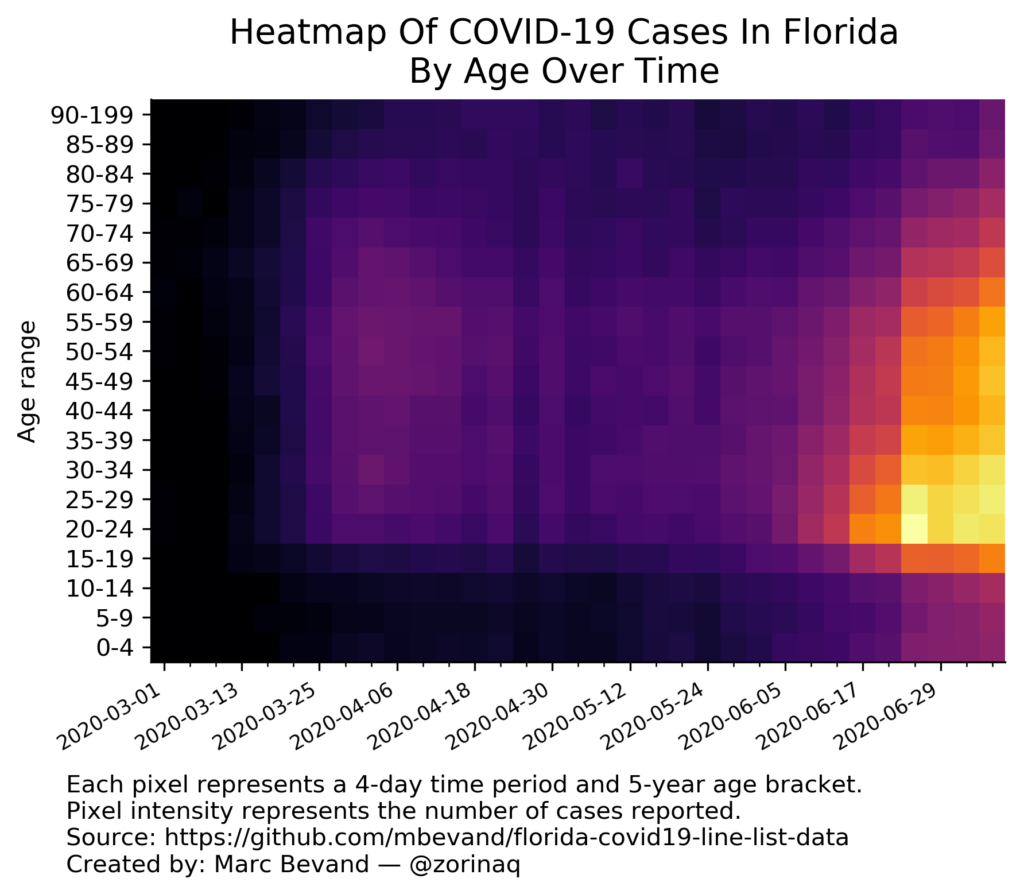
The testing system in the United States has broken down to the point that it is almost completely useless. Labs are running out of critical supplies such as reagents. A 71-year-old man in Utah died waiting on line in the summer heat to get a test. As CNN anchor Victor Blackwell is still waiting for his test results in Atlanta 12 days later, his colleague in Germany, Frederik Pleitgen, received his results back within hours. I myself was tested on Wednesday and was told to wait seven to 10 days for test results in New York. Without efficient (under 48 hours) results, it is impossible to conduct an accurate contact tracing process. Even former White House chief of staff Mick Mulvaney complained about the lag in testing. We need more lab capacity, and this is why I think it is important that all colleges and universities with testing capacity currently serve the public good and help health departments process tests. This will be key to helping us get out of this worsening pandemic and we will discuss more on this idea in the higher ed section of the report. Long delays for testing has stymied our response and without a national testing strategy or the use of the Defense Production Act to augment lab capacity, the United States is set up for failure. One person in Ohio who has had contact with a confirmed case had to wait for 16 days just to get a test. Though a small sample size, this graph shows varying wait times for results across all 50 states.
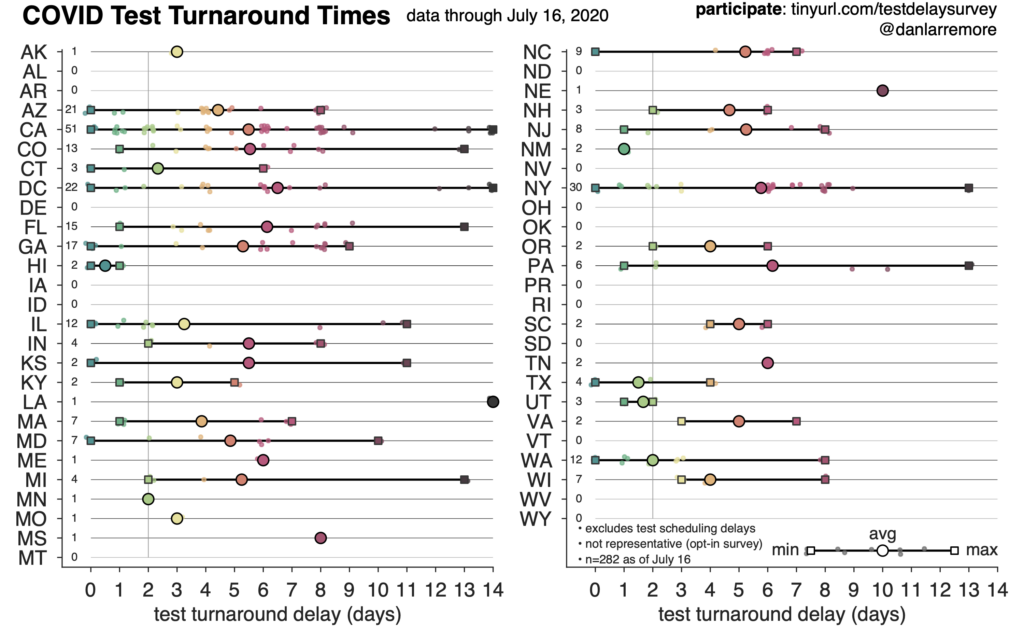
In many states, state governors have caved into political pressure and issued mask mandates.
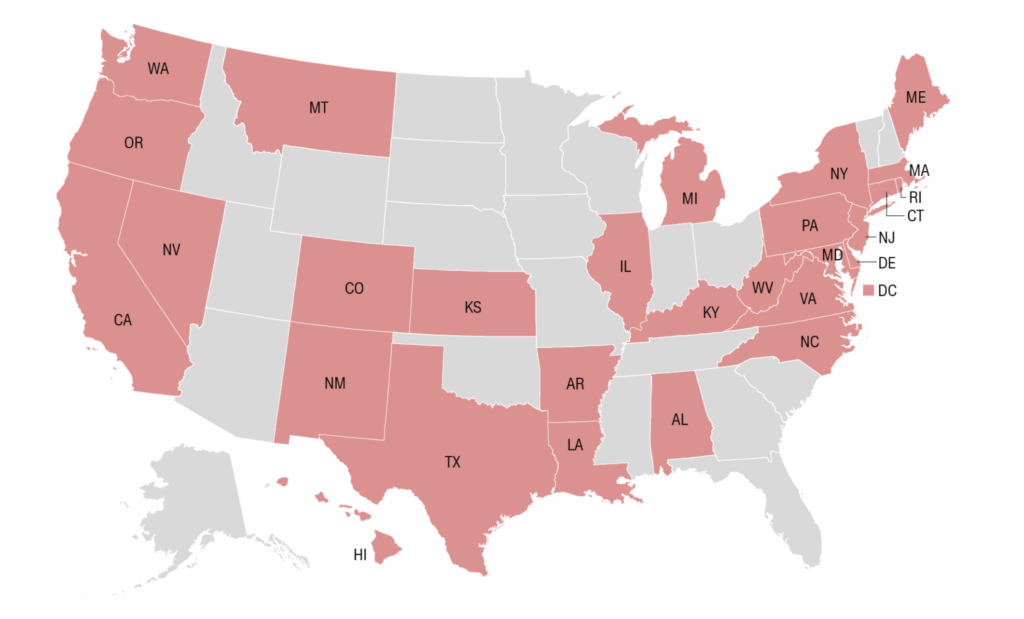
However, some governors continue to put the lives of their residents at risk. The Governor of Georgia has blocked any municipalities or counties from issuing mask mandates and has even personally sued the mayor of Atlanta over her face mask order. Despite many ICUs in his state full to capacity, Florida Governor Ron DeSantis says he won’t close the state’s gyms because “if you are in good shape you have a very, very low likelihood of ending up in significant condition as a result of the coronavirus.” This is not how health, or gyms, work. We have a new cabinet department in this country: The Department of Mixed Messages. A clear message is necessary to ensure more compliance with mask-wearing among the general population. This map and chart show how compliance varies geographically and along demographic and party lines. Mask use is more common among females, Democrats, those in the Northeast and older people, but surprisingly also more low-income people.
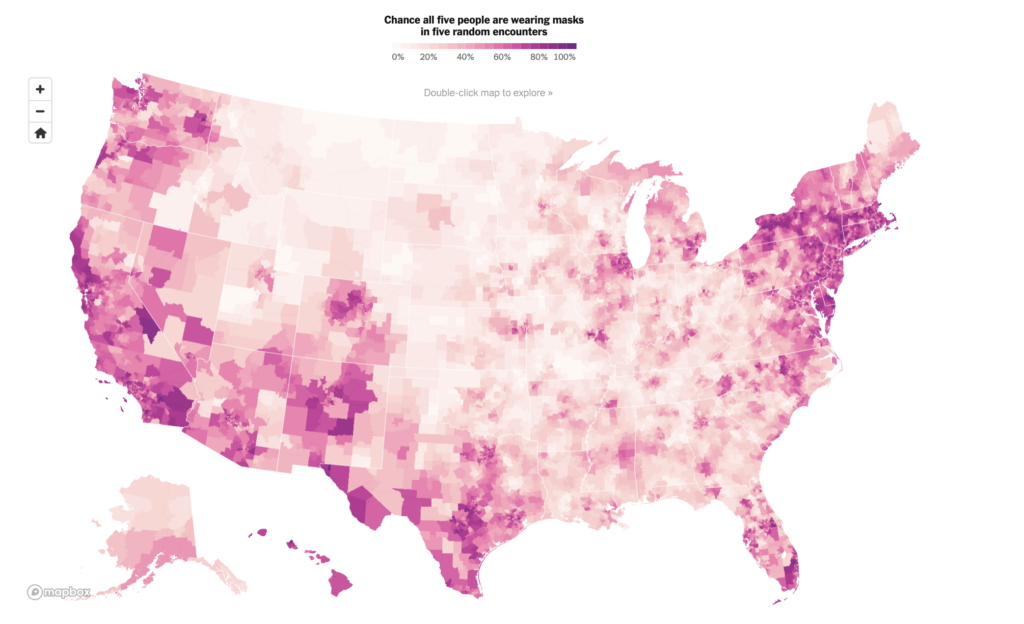
While President Trump did wear a mask when he visited Walter Reed Medical Center last weekend, my analysis shows that compared to other leaders, he waited the longest to wear one. “I’ve never been against masks but I do believe they have a time and a place,” he said. The time and place for wearing a mask is everywhere, everytime. 173 days after the first case was reported in the U.S.,Trump finally wore a mask. It took China’s Xi Jinping 41 days from his country’s first confirmed case to wearing a mask in public. Seems Trump is more passionate about Goya beans than masks. His abysmal response to the pandemic does not amount to a hill of beans.
In addition to his defiance of mask orders, Trump’s most dangerous actions this week lie in sidelining and actively discrediting his top scientific and public health experts. After the White House released opposition-style research to the press on all the times they believed Dr. Fauci made mistakes, Trump’s social media manager posted a disturbing graphic of the doctor and Trump’s trade advisor publicly criticized him in an op-ed. “He has been wrong about everything I have interacted with him on,” Navarro said. While Dr. Fauci has said he will not resign, it is still deeply concerning that these attacks are occurring. Public health should never be political and yet Trump has turned the CDC into a political pawn, four ex-CDC directors write in the Washington Post. Removing hospitalization data from the public view and blocking the CDC director from testifying to Congress on reopening schools are all part of a larger plan by this administration to discredit the science. This is incredibly harmful and will result in more lives lost.
On the issue of schools, due to spikes in viral transmission, many of the nation’s largest school districts have announced either delayed starts or periods of remote learning. These include Los Angeles, San Diego, Atlanta and Montgomery County, Maryland. One study showed that one quarter of all teachers are at higher risk of illness from Covid-19. The National Academies of Science, Engineering and Medicine has said that schools should open in person, with particular emphasis on younger children and those with special needs. New York State has said that for schools to open the locality must have a decrease in cases and an infection rate of below 5%. Yet in the same localities disparities, have emerged between public and private schools, with the latter having more money and resources to open. What is the single-most important change we must make to open K-12 schools? Simple. Close the bars, restaurants and indoor spaces. Get the infection rate down, then you can think about reopening schools.
These five elements are key to our understanding of the worsening pandemic and will provide a roadmap for the weeks ahead.
As usual, more studies have been published and new information is now available to help us better understand Covid-19. Let’s take a look at some of the highlights:
- Anecdotally, we have seen evidence that people could possibly get reinfected, though more study is necessary.
- Masks work, as seen in this study of universal masking in a Massachusetts healthcare facility.
- While there are no proven treatments or therapeutics for mild Covid-19, we have learned quite a bit about how to improve patient care.
- According to one British study, immunity could decline within months of infection.
- A CDC study from a hair salon in St. Louis found that with two infected stylists and 139 clients, no transmission occurred due to everyone wearing masks.
- Universal testing in 11 long-term care facilities found 55% of infections symptomatic. This is similar to the CDC’s estimation of 40% of infections being asymptomatic.
- A CDC study shows that there was sustained transmission in New York City on March 8, while our testing capacity was still stymied. The travel restrictions from Europe took effect on March 13. The strain of the virus found was from Europe. We were too late.
- The steroid dexamethasone has been proven to have some effect in treating the symptoms of those with severe Covid-19.
- We continue to learn about possible mutations to the virus.
- A study of two counties in Wisconsin found different strains of the virus — an Asian lineage clade infected Milwaukee County while a European lineage clade infected Dane County. In Milwaukee County, researchers found evidence of few, early viral introductions giving rise to substantial community spread. In Dane County, there have been more introductions, but less community spread.
- A new study finds that 87% of infections in the original epicenter of Wuhan went undetected and the R0 — the degree of contagion — was up to 3.5.
- A squirrel in Colorado has tested positive for the bubonic plague.
- One family gathering in North Carolina, where attendees did not wear masks or observe physical distancing, caused the infections of 41 people.
- Maryland governor Larry Hogan, a Republican, slammed the federal government’s response. “Meanwhile, instead of listening to his own public health experts, the president was talking and tweeting like a man more concerned about boosting the stock market or his reelection plans,” he wrote in The Washington Post.
- One journalist from Wuhan described her experience with the coronavirus after being infected in Florida. “China is battling one pandemic, whereas each American state, community and person is fighting their own,” she wrote.
- A new poll finds that social distancing across the U.S. continues to decline.
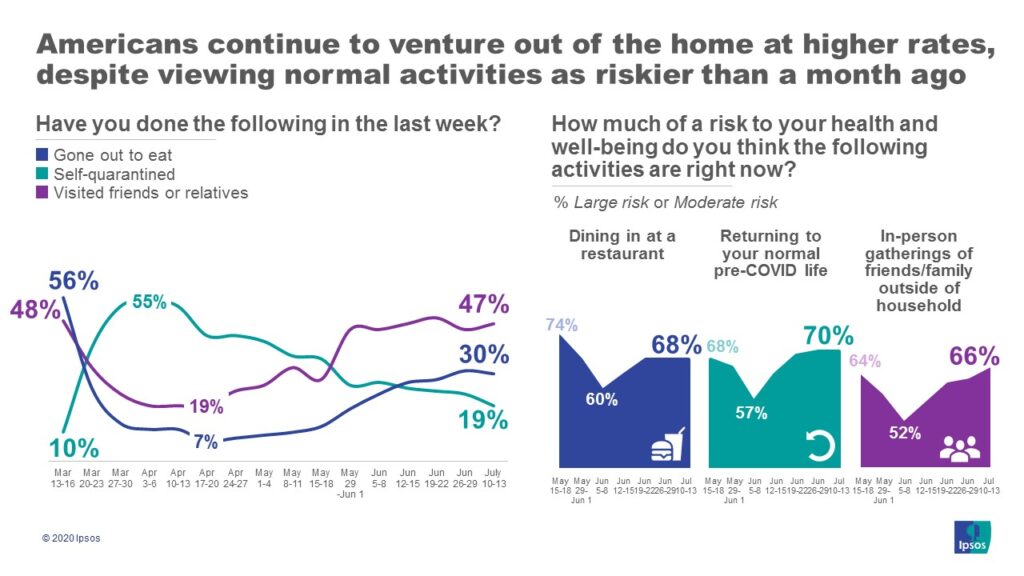
Around the world, we’ve also seen new developments:
- While Florida saw 15,000 cases in one day and opened Disneyland, Hong Kong’s third wave started with 56 infections and the city immediately closed its Disneyland.
- 81 Marines have been infected on a U.S. base in Okinawa.
- The U.S.-Canada border will remain closed to non-essential travel until August 21.
- Schools reopening in Israel could have possibly contributed to a major spike in cases.
- China’s economy has begun to slowly recover with the resumption of group tours and reopening of movie theaters.
- Taiwan and Thailand are lauded as success stories for their stong efforts of epidemic prevention and control.
- A region in Spain has gone into a second lockdown after a spike in new cases.
I remain concerned about South Africa, India and Brazil in particular, where the rate of transmission is increasing at an alarming rate.
We will finish this week’s national discussion with an update on vaccines. Preliminary results from Phase I trials of the Moderna vaccine show that an immune response was mounted in every patient. One big question is whether producing antibodies predicts protection against infection — and how much protection. Another is whether the antibodies will last. Meanwhile, the vaccine produced by Oxford University researchers could be weeks ahead of the others.
In short, our current pandemic response with many states far along their reopening process is not working, so we need to roll it back and impose regulations on businesses and gatherings to give our testing capacity the chance to catch up and our hospitalization rates to decline. The president treating the CDC and his top doctors as some sort of “deep state” organization certainly does not help either.
Having laid down the groundwork on the national scene, let’s take a look at the latest developments in higher ed.
Higher education
The higher ed landscape is at a crossroads. Colleges and universities can either proactively decide to switch to remote instruction before the semester begins (known here as “flipping”) or open in-person for the semester and deal with the ramifications of having cases on campus (the probability of this is quite likely, in my opinion).
Let’s start with an update on the international student guidance released last week, which stipulated that international students taking entirely online classes would not be able to remain in the U.S. In an incredibly short hearing presided over by District Court of Massachusetts Judge Allison Burroughs, Middlebury Class of 1983, the Department of Homeland Security has agreed to rescind the policy from the previous week, as reported by my colleagues Camille Caldera and Michelle Kurilla in The Harvard Crimson. This is a major victory not only for Harvard and MIT, the universities who initially filed the lawsuit, but also all the colleges who filed amicus briefs asserting their support. However, according to the new guidance, the regulations do not seem to permit new students to enter the U.S.: “If Initial students have not arrived in the United States, they should remain in their home country.” However, due to possible travel and visa restrictions, it is likely that many students who are not already in the U.S. will not be able to return.
This week, we have seen more and more schools abandon their plans for in-person instruction and “flip” to mostly remote operations. According to this map, 18 schools have already rolled back their reopening plans.
Why have these schools flipped? In the case of Dickinson College, administrators attributed their decision to three major factors:
- The delay in return of test results, which could impact room quarantine. Students can remain in their rooms for a day or two, but 5-7?
- 300 students would need to quarantine on arrival, which is not possible on a large scale.
- The national outlook has worsened [I have repeatedly mentioned in my reports that higher ed does not operate in a vacuum and it seems schools are finally starting to realize that].
The president of Scripps College, Lara Tiedens, wrote an op-ed in The Washington Post outlining her reasons for shifting online. “The reality is that the anticipated in-person experiences planned for this fall can’t and won’t meet the expectations of our students and their families,” she said. In an interview with Inside Higher Ed, she attributed her decision to a sort of public responsibility. “We need to be socially responsible players in this world,” Tiedens said. “And that means understanding what the nature of the public health crisis is, and what responsible behavior is in that context.”
We have often discussed that reopening schools depends on student behavior. Dr. Sherry Pagoto, a clinical psychologist at the University of Connecticut, held focus group sessions with students, gathering their thoughts on the fall semester. She found that students said a 14-day quarantine before the semester starts is unrealistic and fear automatic quarantine if they report any symptom on a symptom reporting app. In response, she argues that colleges must be clear about their expectations and communication, and must provide frequent updates to the community on outbreak progress.
Testing will be central to any college reopening plans, and many colleges have finally started to realize the cost of such an ambitious testing campaign. The high costs of testing is a concept we discussed a month ago, in my June 12 report. One college president told The Wall Street Journal’s Melissa Korn: “Originally we were planning to test students and others once a week, at a cost of $1 million a month. ‘That would put us out of business,’ he said. As a result, many colleges are requiring that their students receive negative test results prior to their arrival on campus. Some are even mailing test kits to students, however it is worth considering that depending on the method used for sample collection, it is possible that students will inaccurately swab the inside of their nostrils. In many states, that is not possible, due to testing criteria (prioritizing symptomatic individuals) or long wait times for test results. I would make the argument that testing should be a resource provided for the public good, and with a current backlog in testing, it would be preposterous for students to contribute to an already overloaded testing system just to show a proof of a negative test. It should be on the onus of colleges not to further stymie the U.S.’ testing capacity, and when they do have in-house labs, they should be opening these labs at the current moment to run samples from the general public. A 14-day wait time on test results (as is the case in some areas in Florida) is abysmal. Colleges can do their part to serve the public good, and the time is now.
At the same time, testing is seen as an essential component for an on-campus fall semester. “To allow universities to open without testing is to replicate the error at the root of the feckless and incoherent federal response: ignoring the available evidence, hoping for the best, and planning accordingly,” University of Washington biologist Carl Bergstrom writes in The Chronicle of Higher Education. One model emphasized the importance of regular testing. “Even if students are tested once every three days, there are plausible transmission scenarios where 5% or more of a student population could become infected over the course of an abbreviated 80-day semester,” researchers wrote. For next week’s report, we will look at aggregate data of colleges’ testing plans as they continue to change.
As colleges continue to press forward with their reopening plans, some have turned downright wacky and prohibitively costly. Rice University is setting up circus tents for classes and requiring students to bring their own chairs. George Mason University has a fleet of robots to deliver food that students order on an app. The University of Kansas is offering full respirators for their faculty. The University of Pennsylvania has estimated $40 million in one-time costs related to the pandemic. The University of Florida has already seen 27% of their tests come back positive. The University of Georgia is asking faculty to identify their next-of-academic-kin in case a faculty member falls ill, or worse. Dr. Michael Osterholm at the University of Minnesota warned that alcohol, a frequent feature on college campuses, could inhibit students’ ability to social distance.
It is important to realize that many colleges will face difficulties in executing their reopening plans. As reported by The Washington Post, university health centers are already under resourced. States pausing or rolling back phases of reopening could mean that colleges would not be able to open on time. At Ithaca College, students who are traveling from the 22 states on New York State’s travel advisory list (Alabama, Arkansas, Arizona, California, Florida, Georgia, Iowa, Idaho, Kansas, Louisiana, Minnesota, Mississippi, New Mexico, North Carolina, Nevada, Ohio, Oklahoma, South Carolina, Tennessee, Texas, Utah and Wisconsin) will not be allowed to return to campus and will have to take classes remotely until their state has been removed from the mandatory quarantine list, since the school has insufficient space for full quarantine. A Harvard survey found that 70 percent of Harvard students are at least somewhat likely to enroll for the fall semester, while 15 percent are extremely unlikely to stay on, as reported by my colleagues Juliet Isselbacher and Amanda Su in The Harvard Crimson. In order to de-densify, Brown University has secured leases with off-campus apartments, though that may not be possible in the case of more rural schools. An interesting disparity has emerged at Williams College, where Black students and those on financial aid are less likely to return, as reported by my colleague Jeongyoon Han. Princeton University has planned to close all spaces for student organizations. Various liberal arts colleges have incredibly different fall plans, as reported by education futurist Bryan Alexander.
It is also important to consider the effects colleges have on their local communities. As reported by my colleague Isabella Simonetti in Vox, college towns without students have seen businesses struggling. However, some localities have met college reopening plans with deep skepticism. In the case of the University of Virginia, the mayor of Charlottesville called the school’s plan to allow students on campus and have in-person classes “a recipe for disaster.” The town manager of Amherst, Massachusetts, where UMass Amherst and Amherst College are located, wrote a letter to the former’s chancellor and said “I believe these two decisions will endanger the health and, perhaps, lives of those who live in and around the town of Amherst,” referring to a lack of regulations for students living off-campus. A lack of social distancing at the University of Virginia and Pennsylvania State University is cause for concern. “Sadly, I do not believe all of my fellow students are willing to make sacrifices for the greater good of the Penn State and State College communities,” The Daily Collegian editor-in-chief Maddie Aiken wrote. Tulane University has threatened expulsion for partygoers. Reopening is bound to put incredible strain on town-gown relations.
Like most weeks, we must look to the student perspective, as many students have made the moral and practical arguments against reopening. I spoke with Sara Hebel from Open Campus Media about the limitations of this fall’s college experience. “I think people need to realize that they’ll probably be on a campus, taking online classes, and staying in their rooms a lot,” I said. “There’s little attention on the college kids who couldn’t care less if grandma dies in the name of a shot-gunned Bud Light,” University of Georgia student Faith Settipani said in an op-ed and on CNN. “We understand that Pitt will lose money if it decides to go online,” the editorial board at the University of Pittsburgh’s student newspaper wrote. “But we also understand that holding classes online will save the lives of students, yes, but also instructors and community members, too.” Before the college flipped to mainly online instruction, one Emory University student cautioned her peers against returning to campus. “Sweeping plans to reopen campus may prove prohibitively detrimental if, come August, cases have not decreased significantly,” she wrote [it is unlikely that the situation will change dramatically between now and August]. Just one event, such as dinner at a restaurant in the case of University of North Carolina athletes, can contribute to viral spread and could cause colleges to be the next Covid-19 tinderboxes. Students who are at higher risk for severe illness, as well as first-generation students, must receive more support from their institutions. “I grew up always wanting to attend university, and due to Covid I feel as if I’m missing out on the true college experience,” one first-generation student told my colleague Alison Berg at The Chronicle.
It’s not just students. Faculty have cautioned against reopening as well. Some risks are worth taking,” faculty members at Appalachian State University wrote. “A full return of the student body in August is not one of those.” One PhD candidate and instructor at the University of North Carolina wrote an op-ed with five reasons against in-person instruction.
With students experiencing drastic changes to their college experiences for the fall, the effects of Covid-19 are likely to make an impact on the mental health of many for some time, as reported in the Chronicle.
With some students already on campuses, how are their infection rates progressing? In short, not too well. The test positivity rate in the USC community has climbed over the last two weeks, reaching 8.9% for students and 1.8% for employees tested at Student Health from July 5 to 12 [remember that under 5% is recommended by the World Health Organization to advance reopening stages]. Another 25 students at University of California, Berkeley have tested positive for coronavirus in an outbreak largely linked to fraternity and sorority parties earlier this month. As more schools continue to cast doubts on playing the football season due high levels of infections nationally, I have tracked at least 584 confirmed cases across the country. If college athletics were a country, it would be 155th in the world for its high case count, behind Angola.
We have previously discussed the concept of a “threshold” — what it would take to take action on college campuses to suspend classes or send students home. In the case of the University of Texas at Austin, we have seen some metrics the university will use to decide. While not numerically defined, they point to community criteria (government action), campus criteria (the increase of students testing positive, or worse, a student death) or shortages of PPE. I do hope that we will see more gating criteria by other colleges in the weeks going forward.
We have now begun to realize that plexiglass will not save us, as Jeff Selingo writes. “The clear message is that it’s easier for colleges to purchase plexiglass than redesign pedagogy,” he says in the Chronicle. “2,800+ cruise ships retrofitted with white boards and a younger cohort will set sail in the midst of a raging pandemic. The density and socialization on these cruise ships could render college towns across America the next virus hot spots,” NYU Stern School of Business marketing professor Scott Galloway writes. I am concerned with the impact of hundreds of thousands of college students traveling across the country in the coming weeks, along with other Americans moving around for some late summer travel. This could present a situation similar to China’s Spring Festival travel period, which was seen as a large migration that accelerated the spread of the virus, as I discussed in my first coronavirus update on January 21. I think one of the key elements we have realized about colleges reopening is that the national situation has made it more challenging to reopen safely. We had expected the pandemic to subside by now and it has not. College communities are expecting more detailed plans for reopening but are currently not receiving them due to the abundance of unknowns. It is for this reason that I think we will see many colleges continue to go remote in the coming weeks, especially since ICE guidance has put less of a pressure on them to reopen. We’re running out of time here.
Study abroad and international travel
We have already discussed recent updates to international students remaining in the United States, so I will keep this section short. One research report from the National Foundation for American Policy, written before the ruling to allow current students taking online classes to remain in the U.S., reported that “enrollment of new international students at U.S. universities could fall to the lowest level since after World War II, while U.S. average annual labor force growth, a key component of economic growth, may be 59% lower due to Trump administration policies that have reduced legal immigration.”
According to the State Department, U.S. Embassies and Consulates began a systematic phased reopening of visa processing on July 15 and it seems they will expedite visa processing for students. This is cause for hope. An update from the State Department also said that students coming from Europe and the UK will be exempt from the entry ban on travelers to the U.S. However, students from a number of other countries will still face restrictions, most notably China. In my conversations with Chinese students, some of them plan to go to Cambodia (which does not require a visa for Chinese nationals) for 14 days and then fly to the U.S. through Seoul. We will see how many students pick this option.
The Good Stuff
Let’s roll the clips of the good stuff. In my usual tradition, I feature my favorite stories from the week. Here are my Top 11.
- The team at Johns Hopkins has been working nonstop to keep their pandemic map updated, recording every single confirmed case in the world.
- Then-vice president George H.W. Bush pays tribute to Dr. Fauci at a presidential debate in 1988.
- Vermont photographer Caleb Kenna shares his aerial photographs in The New York Times.
- College students and recent graduates start internships and jobs from their childhood bedrooms.
- Jimmy Fallon is back in his studio in New York and interviewed Governor Andrew Cuomo.
- One Greek college student biked 48 days from Scotland to Greece to return home to his family when flights were canceled.
- Everything seemed to turn into cake this week, the latest in internet memes.
- Tuna fish has surged in popularity thanks to pantry loading during the pandemic.
- The Minnesota State Fair is canceled because of the pandemic, but the tradition of sculpting a Minnesota dairy princess out of a block of Grade A salted butter will continue.
- The team at The Daily Iowan, the University of Iowa’s student newspaper, has continued to publish a weekly print edition throughout the spring, as seen in this documentary.
- InStyle magazine profiled CNN White House correspondent Kaitlan Collins, one of the youngest journalists to hold the position.
Conclusion
ICUs filled to capacity. Hospitals close to running out of PPE. Testing lines spanning entire parking lots. In many parts of the country, our healthcare system is overwhelmed. Yet some members of the public seems to blatantly disregard that we are currently in a pandemic. In some places, lockdowns (or significant business closures) are becoming our only possibility. I fear that actions people take (or not) throughout the rest of the summer and into the fall will only be more detrimental to viral spread. Why? Look at mobility. With hundreds of thousands of college students returning to campuses and millions of Americans returning to work, combined with a fall where people tend to be inside (increasing viral transmission), CDC Director Robert Redfield said that “the fall and the winter of 2020 and 2021 are going to be probably one of the most difficult times that we experienced in American public health.” We need clear communication, ramped up testing and a new national strategy that encourages public compliance. We need to reset and reverse, for the sake of the lives of millions of Americans.
I’d like to thank all the student journalists with whom I have the pleasure of working. In the next weeks and months ahead, they will become ever more important in chronicling their colleges’ decisions for the fall and beyond. Support their work by reading it.
My best to all for good health.
Like what you see? Don’t like what you see? Want to see more of something? Want to see less of something? Let me know in the comments. And don’t forget to subscribe to the weekly newsletter!
For more instant updates, follow me on Twitter @bhrenton.
